- Accueil
- Base de données
- 35
- USAAF
- 8 July 1944
8 July 1944
Martin B-26-B-45-MA "Miss Take" (s/n 42-95821 code O8-O)
"Les Places" - Coësmes (35)
(contributors : Daniel Jolys, Jean-Pierre Lebée, Pierre Lauglé, Daniel Dahiot, J.P. Favrais, France Crashes 39-45)
 © Jean-Marie Guillou
© Jean-Marie Guillou
Crew (391st BG, 575th BS)
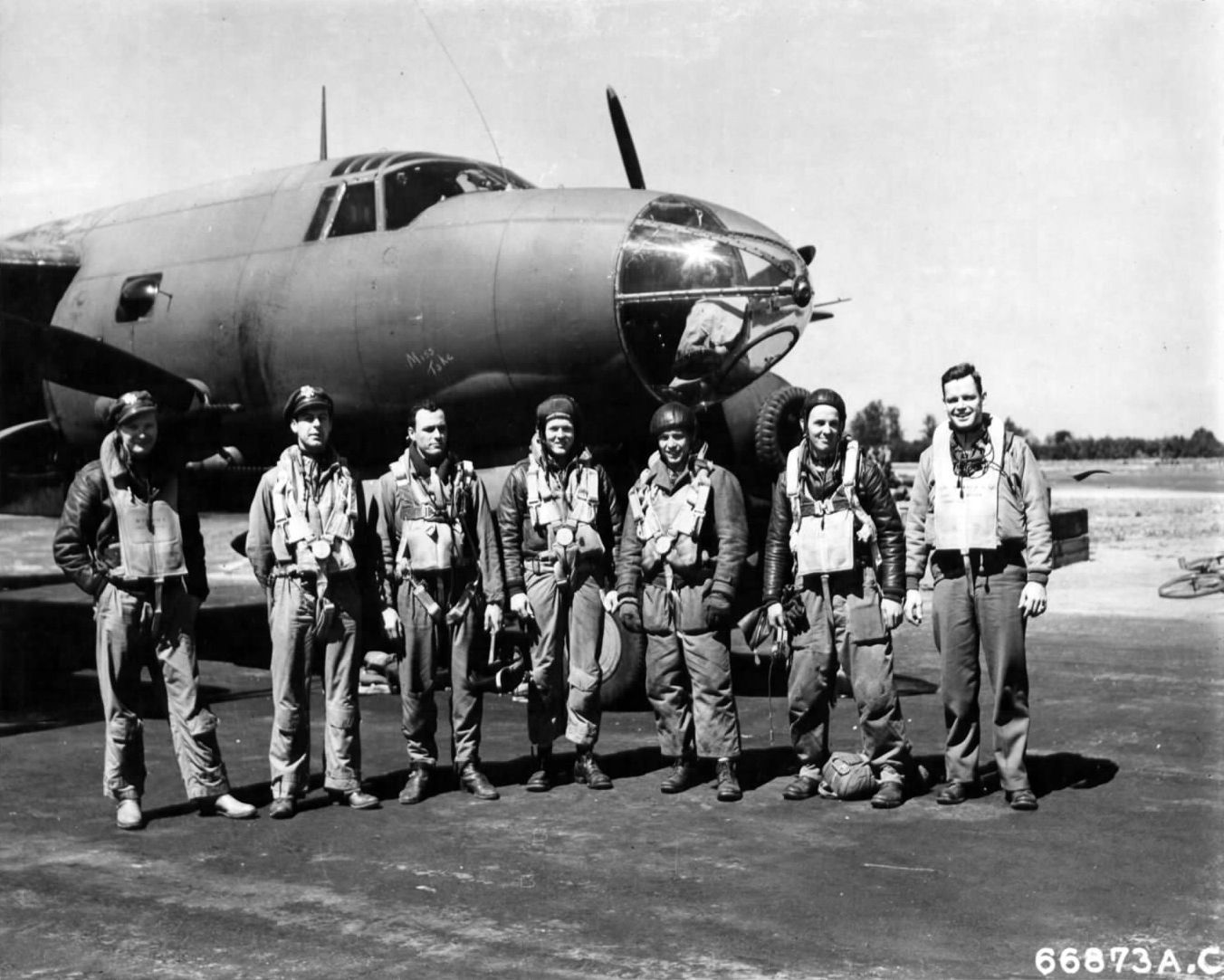
The Martin B-26 Marauder « Miss Take » and its crew, returning from their 100th mission on June 20, 1944.
Left to right : Lloyd V. Alexander, Edgar G. Williams, George W. Stalnaker, Francis J. Murphy, Richard B. Smith,
Stanley W. Miller, Eugène R. Squier.
Photo - NARA 342-FH-3A11102-66873AC (public domain)
- (Pilot) Lt Col. George W. STALNAKER (service number O-23784), from New-York, New-York State (USA).
Escaped, returned to duty on August 3, 1944.
- (Co-pilot) 2nd Lt Eugene R. SQUIER (service number O-757317), from San-Francisco, California (USA).
Escaped, taken in by the OCM network (François Langouet), returned to duty unit upon liberation.
- (Navigator) Capt. Edgar G. WILLIAMS (service number O-791015), from Glen Falls, New-York State (USA).
Escaped, returned to duty on August 3, 1944.
- (Navigator) 1st Lt Jim B. CLARK (service number O-669006), from Lubdock, Texas (USA).
Escaped, returned to duty on August 3, 1944.
- (Bombardier) 1st Lt Francis J. MURPHY, (service number O-534318), from Sacramento, California (USA).
Escaped, returned to duty on August 3, 1944.
- (Wireless operator, air gunner) T/Sgt Richard B. SMITH (service number 20314269), from Natrona, Pennsylvania (USA).
Escaped, returned to duty on August 3, 1944.
- (Engineer, top turret gunner) S/Sgt Stanley W. MILLER (service number 36453560), from Benton Harbor, Michigan (USA).
Escaped, returned to duty on August 3, 1944.
- (Tail gunner) S/Sgt Lloyd Vernon ALEXANDER (service number 35330756), from Mishakawa, Indiana (USA).
P.O.W., Stalag Luft 4, Gross-Tychow, Pomérania, Poland.
THE STORY
by Daniel Jolys, "Cercle d’Histoire du Pays Martignolais" (photos by the author unless otherwise stated)
From June 6, 1944, the date of the Normandy landings, the 391st Bomber Group (BG), based northeast of London, has been carrying out bombing missions in the west and north of France. This air group belonged to the 9th American Air Force (USAAF), which was under fire from the start of Operation Overlord. Its objectives were to support Allied troops on the ground and destroy all strategic points used by the enemy.
Early in the afternoon of Saturday, July 8, 1944, Lieutenant Colonel George W. Stalnaker, commanding officer of the 575th Bomber Squadron of the 391st Bomber Group of the USAAF, was about to enjoy a two-night leave in London. A well-deserved rest, he thought, after six weeks of continuous missions as part of Operation Overlord.
But around 4 p.m., the reality of war called him back into the operations room to study a new target over Nantes, specifically the so-called "Pornic" railway bridge spanning the Loire river. George Stalnaker was tasked with leading a formation of 36 B-26 Marauder bombers planned for this mission. As "leader," he carefully examined the imposed flight plan and was concerned about the "red line" along the Loire estuary. This indication determined the location of the numerous 88 mm Flak batteries for the protection of the German installations scattered throughout the port area. The officer could not help but exclaim : " Who was the stupid guy who drew that route there ? ". At the same time, embarrassed, he noticed behind him General Herbert Thatcher, his commanding officer, who replied attentively : " Well don't worry George, our fighters will destroy all the anti-aircraft guns on the Loire river."
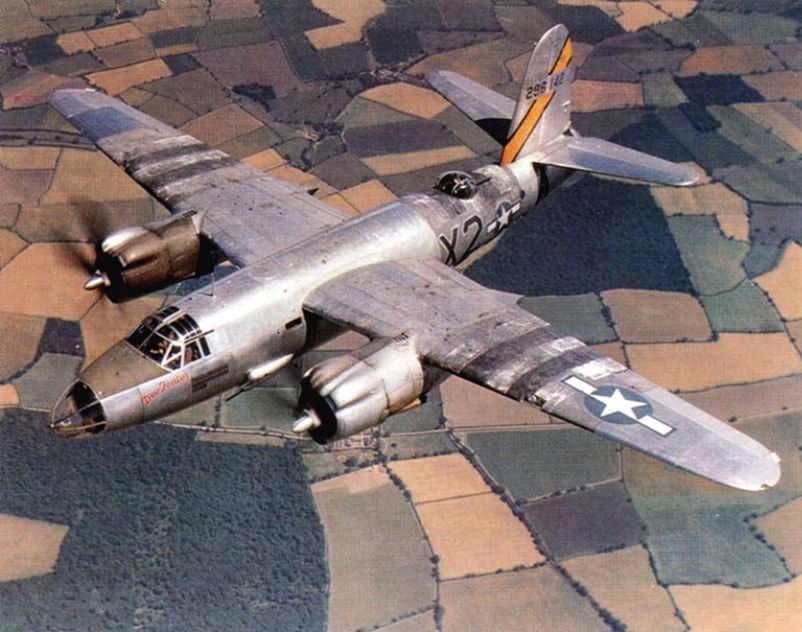
A Martin B-26 Marauder in 1944, with black and white invasion markings.
Photo USAAF - author Charles E. Brown - public domain
George Stalnaker's skepticism was compounded by unfavorable weather and a rather unusual late departure schedule. Around 6:30 p.m., he boarded the lead B-26 aircraft, coded O8-O on the fuselage and with the friendly nickname Miss Take (a play on mistake). Seven crewmen accompanied him : Second Lieutenant Eugene R. Squier, co-pilot ; Captain Edgar G. Williams, navigator; First Lieutenants Francis J. Murphy, bombardier, and Jim B. Clark, navigator; Technical Sergeant Stanley W. Miller, engineer and gunner; and Sergeants Richard B. Smith, wireless operator and gunner, and Lloyd V. Alexander, tail gunner. In the cockpit of the B-26 Marauder "Miss Take", George Stalnaker, on his 35th mission, was still worried. Was this a premonition ? On the runway of Matching Green base No. 166, the third green light authorizes takeoff.
At around 8:30 p.m., the B-26s flew over Saint-Nazaire, the initial planned point, at an altitude of 3,000 meters. The bombers were in the clouds. Jim Clark, the navigator, defined the "bomb run," that is, the obligatory straight line path toward the objective. The 36 bombers, grouped in two "boxes," headed toward the target in close formation. The powerful German anti-aircraft batteries protecting Saint-Nazaire opened fire on the twin-engine aircraft. "A hell of a fire," George Stalnaker would later write in his memoirs. Simultaneously, the accompanying P-47 Thunderbolt fighters pierced the clouds to strafe the flak positions. But the German gunners were experts : six 88 shells in front of the formation, six to the side, and six behind, sending a multitude of metal fragments into the air at a frantic rate. The navigator counts down the minutes until the bombs are released. Stanley Miller, the gunner, reports that the starboard engine is on fire, emitting a lot of smoke. Then the port engine receives one or two hits "in the nostrils," as the pilot said. The bursts of 88 shells become more and more dense, riddling the sides of the B-26s with steel debris. George Stalnaker, with the energy of desperation, tries to control his twin-engine aircraft, which loses altitude while remaining in the "bomb run." Above the target, Lieutenant Francis Murphy, glued to his Norden bombsight, orders the bombing run, causing turbulence due to the 1,000 kilos of bombs escaping from the aircraft.
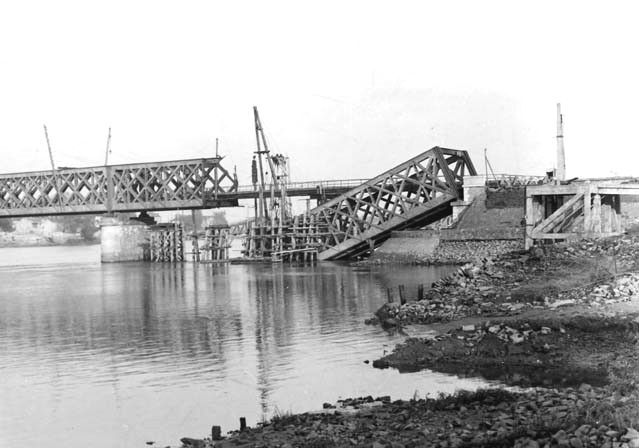
The Pornic bridge bombed on July 8, 1944.
Photo - Departmental Archives of Loire-Atlantique
Now, George Stalnaker had only one thing on his mind: to get out of this hellish zone as quickly as possible. On the return journey, he followed the pre-established flight plan towards Châteaubourg and the Cotentin Peninsula with partial engine power, hoping to reach an emergency landing site in the liberated zone of Normandy. Captain Edgar Williams, the navigator, calculated an altitude loss of 150 meters per minute and quickly contradicted this hope with appropriate humor : "Colonel, with this rate of descent, we will be 6,000 meters below the ground when arriving in Normandy." At that moment, the B-26 Miss Take was flying over the Châteaubriant region. Stalnaker quickly made the necessary decision; he forced his crew to leave the stricken aircraft. Within seconds, seven parachutes landed gently in the towns of Coësmes and Retiers. The pilot remains alone on board, trying to balance his aircraft as he heads towards the La Guerche forest, but in vain. Stalnaker has no other option but to bail out.
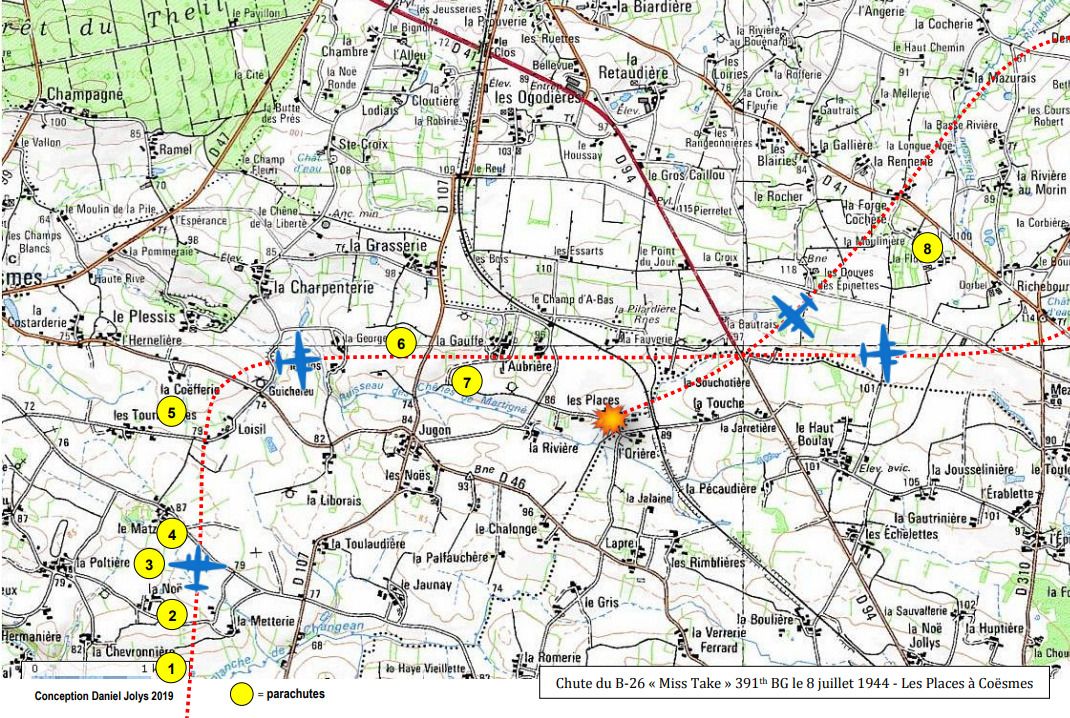
 S/Sgt Stanley W. MILLER, engineer and gunner, recovered by villagers, joined the group
S/Sgt Stanley W. MILLER, engineer and gunner, recovered by villagers, joined the group ![]() Capitaine Edgar G. WILLIAM, navigator
Capitaine Edgar G. WILLIAM, navigator
![]() 1st Lt Francis J. MURPHY, bombardier
1st Lt Francis J. MURPHY, bombardier ![]() 1st Lt Jim B. CLARK, navigator, wounded in the legs, discovered by Joseph BODARD
1st Lt Jim B. CLARK, navigator, wounded in the legs, discovered by Joseph BODARD
![]() T/Sgt Richard B. SMITH, wireless operator, air gunner
T/Sgt Richard B. SMITH, wireless operator, air gunner ![]() S/Sgt Lloyd V. ALEXANDER, tail gunner, P.O.W. at Stalag Luft 4
S/Sgt Lloyd V. ALEXANDER, tail gunner, P.O.W. at Stalag Luft 4
![]() 2nd Lt Eugene R. SQUIER, co-pilot, hidden in Martigné-Ferchaud and at Joseph Bodard's in Coësmes until the Liberation on August 4, 1944
2nd Lt Eugene R. SQUIER, co-pilot, hidden in Martigné-Ferchaud and at Joseph Bodard's in Coësmes until the Liberation on August 4, 1944
![]() Lt-Colonel George W. STALNAKER, pilot, Commanding officer of 575th BS. Left the B-26 last
Lt-Colonel George W. STALNAKER, pilot, Commanding officer of 575th BS. Left the B-26 last
The pilot of the only P-47 Thunderbolt fighter escorting the twin-engine aircraft in its irreversible descent, with a flap of his wings, wishes his brother in arms good luck. A few seconds later, the B-26 "Miss Take", unbalanced, turns 180 degrees southeast of Retiers and then falls obliquely towards the place called "Les Places en Coësmes" where it explodes in the farmyard. It is 9 p.m. The Colin family, leaving there, stunned by the explosion, reports no injuries. The German observation tower of the Luftwaffe, of the 13th company of the Rennes air district, installed on the roof of the "Bonne Brise" villa in Martigné-Ferchaud, followed the trajectory of the damaged B-26 and immediately alerted its headquarters.
Courageous Patriots
Once on the ground, near the place called "La Forge Cochère en Retiers", George Stalnaker was surrounded by several people who rushed to help him. One of them, Emile Soulas, who had some knowledge of English, asked him to remove his Mae West life jacket and follow him quickly because the Germans would soon arrive. Once hidden, in the Soulas family house at "La Pommeraie", in Coësmes, the American officer swapped his uniform for less elegant peasant clothes. His graduation ring from the West Point Military Academy was removed and sewn into his trousers. Somewhat disappointed, he spent his first night in the basement of the house. He thought about his comrades. What happened to them ?
Stanley Miller left the aircraft first, followed by Edgar Williams, Francis Murphy, Jim Clark, and Richard Smith, and he landed near the village of "La Poltière", in Coësmes. Jim Clark, injured in the legs after violently hitting a tree, managed to hide in a bush while waiting for nightfall. Lloyd Alexander touched down further north near the village of "Coëfferie" in the same town. Eugene Squier, the co-pilot, found himself alone in the wilderness somewhere between Coësmes and Retiers.
Jim Clark was finally discovered by Joseph Bodard, an intrepid refugee from Rennes, who took him to his home in "La Poltière". There, he met Francis Murphy and Edgar Williams hiding in the hayloft. Joseph Bodard informed them that he could not keep them any longer because of the German patrols that were operated in the area, looking for the airmen. The hosts knew the risks involved. Emile Soulas forced George Stalnaker to hide in the middle of a wheat field for an entire day. The following night, he was taken to Coësmes where, to his great surprise, he joined four members of his crew : Williams, Murphy, Clark and Smith, gathered by Joseph Bodard. The five airmen thus gathered were hidden in a barn. Not for long, since their hosts moved them to the Theil forest, a kilometer north of Coësmes, where they would spend two to three days. Another surprise awaited them : Stanley Miller had just been rescued by villagers while he was traveling alone on his bicycle with the firm intention of reaching Spain, simply following the procedure instilled in the event of a crash in occupied France. So the crew of the B-26 Miss Take was almost complete. George Stalnaker still had no news of Eugene Squier and Lloyd Alexander.

On the evening of July 12, two resistance fighters from Poligné, Joseph Jochault alias Antoine and André Raton alias Victor, arrived in the Theil-de-Bretagne forest in a Renault car. Without hesitation, they informed the airmen : "We will take you to another safer place." Packed into the car, the eight men arrived at the entrance of Poligné, a small town north of Bain-de-Bretagne. Carefully, the group slipped through the trees to reach their new refuge, a barn belonging to the Olivo family. Approached by the Resistance, the Olivo couple, who ran a grocery store in the center of the small town, readily agreed to house the six American airmen. Their four children, Marinette, Marcel, Auguste, and Camille, were taken into their confidence.
Stay in Poligné
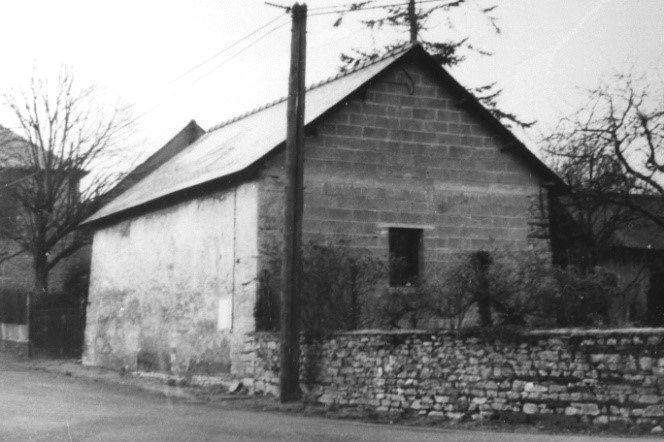
The barn in Poligné - Photo private collection
The barn, nothing like a luxury hotel, is simply furnished : a toilet area, mattresses stuffed with hay, wool blankets, and a small radio to pick up the BBC. In the following days, the children, and often Marinette, bring meals to the escapees. Very quickly, a certain familiarity develops between the Olivo family and their new "six big boys." Of course, there is no question of them leaving their hiding place, day or night; it would be too risky. Supplying food to these young fellows who have fallen from the sky requires strict organization and a certain discretion during this period of rationing.
With the help of a few farmers, Marinette Olivo travels by bicycle to the farms, buying the essentials to ensure meals. Upon their arrival in Poligné, the six Americans appeared very tired from the hardships of the previous days. The warm welcome and dedication of the Olivo family revived them despite the lack of freedom. The two resistance fighters, Antoine and Victor, regularly came to check on their protégés. They recommended to George Stalnaker and his men to stay in the barn as long as necessary and to listen carefully to the BBC news in order to follow the American advance in Normandy.
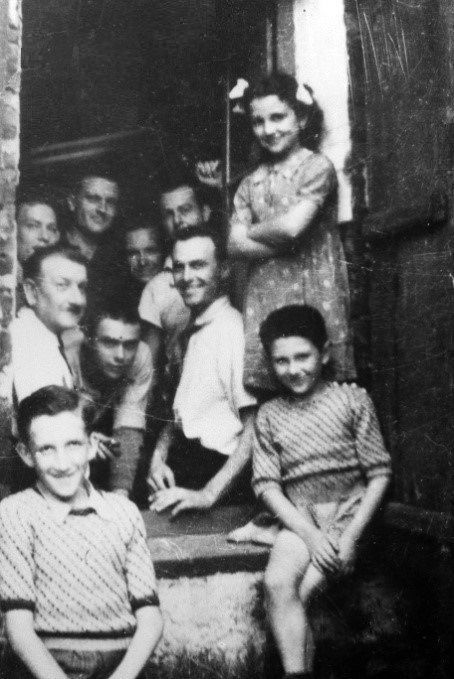
The aviators and the Olivo family in the barn - Photo private collection
In July 1944, refugees fleeing major cities like Rennes and Nantes due to the intensity of aerial bombardments, arrive in the countryside. In Poligné, this new population worries the Olivo family and the resistance fighters. They hope that their residents are not discovered in their shelter. Therefore, extra caution is required. The town of Poligné is also crossed by the national road 137 from Rennes to Nantes, a route heavily used by German convoys. Sometimes soldiers stop to eat in a bistro located not far from the barn. One day, an incident involving a customer and soldiers almost escalated. Antoine and Victor decide to move the airmen to Saint-Ganton, a town located southeast of Pipriac, about 20 km from Poligné.
Saint-Ganton - Pipriac - Vitré.
At nightfall, the Americans emerged from their hiding place with great discretion and jumped into a carwaiting for them in the dark. The driver was Pierre Aubron who stole the vehicle to the Germans of the Todt organization. George Stalnaker remembers : « the driver had the accelerator on the floor, often driving without headlights and he never stopped at road intersections, he honked his horn and crossed at full speed ». Arriving at a café in Saint-Ganton, the airmen were received by Pierre Pineau, alias André Benard in the Resistance. They were housed in the village of La Roche, in a small house run by an elderly lady. Three days later, on the evening of July 28, the fugitives had to leave quickly the place. The partisans, informed of a coming German operation in the area, arrived with several bicycles and led the Americans to the « Tertre Danet » wheat mill in Pipriac. New clothes were provided to them as well as berets and false identity cards. There too, George Stalnaker had an anecdote : « The partisans taught us to keep our cigarettes in our mouths and not to take them out all the time, because that might make us stand out as Americans ». In fact, the guides were preparing the group for a longer cycle journey towards Vitré. Pierre Pinot and Jean Marion were expected to escort them.
On July 31, when they arrived in Vitré, they were welcomed by the police commissioner who lodged them in a beautiful residence, located in the city center, owned by Mr. Mirault, Director of the « Banque de France ». Behind the windows, the airmen observed the German convoys crossing the city in good order. On August 3, early in the morning, as agreed, gendarmes from the brigade of Vitré led the Americans to the Chemin Champlet, at the city limits, where they were expected by the local Resistance. Among them, Francis Langouët, a farmer, took the group through the countryside toward his farm located at « Le Teilleul » in Pocé-les-Bois. There, airmen could feed and rest. George Stalnaker, in his recollections, did not forget this place : "We drank cider all afternoon." At nightfall, Francis Langouët and the airmen left again across the fields towards Livré-sur-Changeon, where they joined elements of the 2nd American Cavalry Reconnaissance Squadron which was preparing the liberation of the town of Vitré on August 4 in the morning. It was the end of the nightmare. The survivors of the B-26 Miss Take were taken to the headquarters of General Wood's 4th US Armored Division, located near Saint-Aubin-d'Aubigné, north of Rennes..
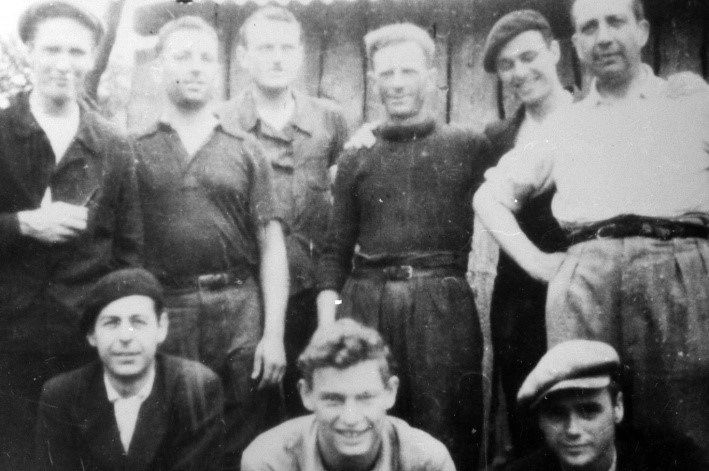
August 1944 - Front row : E. William, S. Miller, R. Smith.
Back row : F. Murphy, Jean Marion, J. Clark, Pierre Pinot, G. Stalnaker and Mr Mirault from Vitré (not confirmed).
Photo private collection
Back in England.
On August 6, 1944, George Stalnaker and his comrades landed on their departure base in England. Three days later, in London, he found with a certain emotion, Eugene Squier safe and sound. The co-pilot told his less eventful adventure. After having covered about ten kilometers in the countryside, helped by his compass, in the direction of the south, Eugene Squier presented himself in an isolated farm, probably at Mr. Chevrollier's farm, at « La Petite Goupillère » in Martigné-Ferchaud, who provided him civilian clothes. Then he was taken to neighbors in the village of Perrières where he stayed for six days. Around July 16, Joseph Bodard, well informed, took him in and invited him to stay with him until the Liberation of Rennes on August 4, 1944.
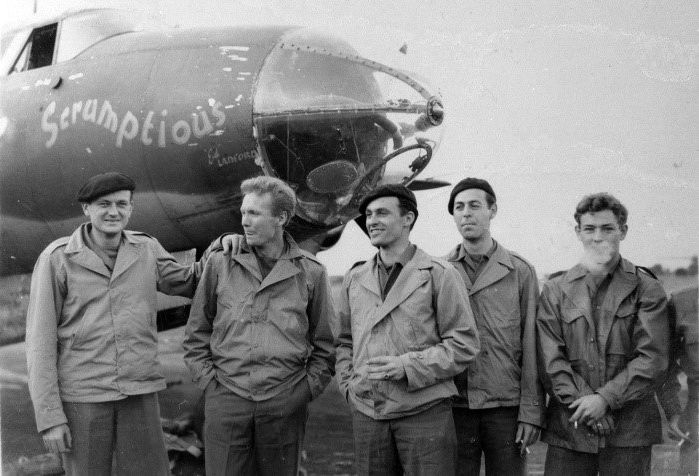
Airmen back to England kept their berets !
The B-26 in the background is B-26 s/n 42-95847 "Scrumptious" of the 575th BS, 391st BG
Photo private collection
As for Lloyd V. Alexander, he did not have the luck of his compatriots. Shortly after his arrival on the ground, he was captured by a German patrol, probably near the place called « La Coëfferie » in Coësmes. Prisoner of war, he was transferred to Germany at the temporary camp of the Luftwaffe (Dulag Luft) in Wetzlar then Stalag Luft No. 4 in Gross Tychow, in Pomerania, and at the sinister camp of Wöbbelin until its liberation on May 3, 1945 by the 8th American infantry division.
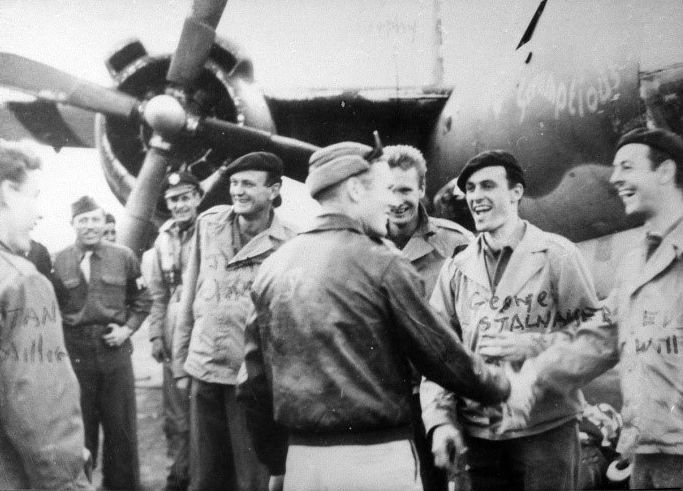
Homecoming on Matching Green base.
Photo private collection
After a short stay in London, George Stalnaker and his team, exempt from bombing missions, returned to the United States. Their unusual adventure sparked unwavering friendships with their French hosts that would last a long time after the war.
Epilogue.
On Sunday July 9, 1944 and the following days, the neighbors and many curious people went to the scene of the fall of the B-26 'Miss Take'. The twin engine bomber was literally pulverized by the explosion. Instinctively, some walkers left with a piece of the wreckage, as a kind of relic. Léon Dézalleux, a farmer at « La Jarretière-en-Martigné-Ferchaud », a village located at about one kilometer from « Les Places », had kept a part of a fin from the bomber. Many years later, one of his friends from Martigné-Ferchaud, Henri Delcourt, got rid of this piece of light metal with a little idea in mind. The metal structure of the B-26 aircraft was made of Duralumin, a light and resistant alloy, type ALCLAD 24S-T 1, a material relatively easy to work. These aircrafts were manufactured by the Glenn L. Martin factory in Omaha, Nebraska (USA). Henri Delcourt therefore bent, drilled, riveted and arranged this part of the twin engine bomber to transform it into a « fishing box », an essential accessory for this passionate fisherman. Today, Henri Delcourt carefully preserves this original box, one of the last traces of the B-26 ‘Miss Take’.
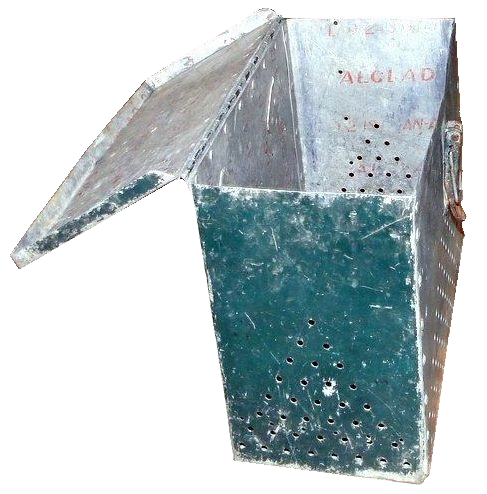
Fishing box made by Henri Delcourt
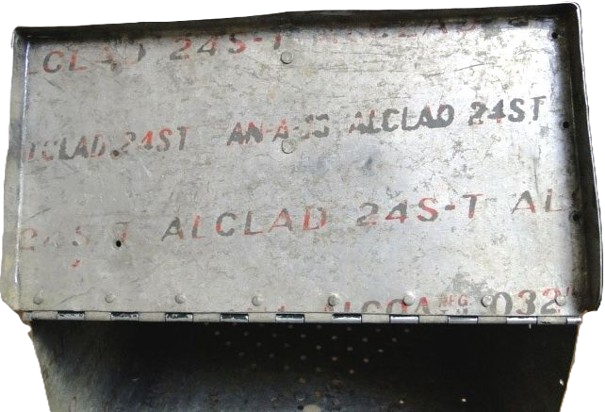
Interior of the box with ALCLAD 24S-T inscriptions
1 Audrey Cochard : "Microstructures et propriétés mécaniques des alliages de type Duralumin : archives-ouvertes.fr"
Sources : Magazine " Memories # 10 (1998)" translated by Marcel Derouallière, August 1944 reports IS9 WEA from British MI 9, MACR # 6649, Ouest-France 1984, Flash Infos # 36 octobre 2010 "Pocé-les-Bois, Guipry-Messac ‘au rythme des bottes allemandes’" from Pierre Lebreton, 2007, Departmental Archives of Loire Atlantique.
Thank you to Pierre Lauglé, Marcel Communal, Raymond Desmots, Marcel Chevrollier, Mme Veillaux nee Colin, Claude Perrois and Raymond Tellier. Courtesy of Henri Delcourt for the presentation of his fishing box.
Photographs : http://www.384thbombgroup.com

Ajouter un commentaire